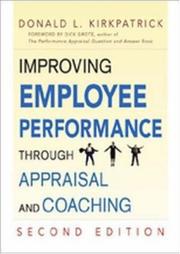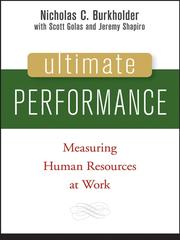| Listing 1 - 10 of 14 | << page >> |
Sort by
|
Book
Year: 2021 Publisher: Washington, D.C. : The World Bank,
Abstract | Keywords | Export | Availability | Bookmark
 Loading...
Loading...Choose an application
- Reference Manager
- EndNote
- RefWorks (Direct export to RefWorks)
This EFI Insight note distills the key principles of effective performance management in the public administration from literature and international good practice. First, it presents the objectives and different approaches and tools for performance management, and then it details seven success factors that should be considered when designing and reforming public sector performance management systems: (1) start performance management from the top; (2) align organizational and individual goals ('clear line of sight'); (3) tailor performance assessment to institutional and job characteristics, and adequately differentiate between levels of performance; (4) improve manager judgment and diversify the sources of information for performance appraisals to ensure objectivity and fairness in assessment; (5) motivate staff through both intrinsic and extrinsic incentives; (6) enable staff through adequate opportunities for growth and development; and (7) embed performance management in organizational culture and practice.
Book
ISBN: 2913488315 9782913488311 Year: 2005 Publisher: Montrouge: Agence nationale pour l'amélioration des conditions de travail,
Abstract | Keywords | Export | Availability | Bookmark
 Loading...
Loading...Choose an application
- Reference Manager
- EndNote
- RefWorks (Direct export to RefWorks)
Vocational qualifications --- Qualifications professionnelles --- Management --- Gestion --- AA / International- internationaal --- 658.301 --- Beroepsselectie. Functieanalyse. --- Performance --- Organizational effectiveness --- Employees --- Personnel management --- Evaluation --- Training of --- Rating of --- Beroepsselectie. Functieanalyse --- Performance - Evaluation --- Organizational effectiveness - Evaluation --- Employees - Training of --- Employees - Rating of
Book
ISBN: 3954890933 3954895935 9783954895939 9783954890934 Year: 2014 Publisher: Hamburg, Germany : Anchor Academic Publishing,
Abstract | Keywords | Export | Availability | Bookmark
 Loading...
Loading...Choose an application
- Reference Manager
- EndNote
- RefWorks (Direct export to RefWorks)
The study was carried out to investigate the effectiveness of teachers' performances in secondary schools. This investigation is based upon the methods of qualitative and quantitative approaches, and is carried out amongst selected schools in Kabale Municipality, in the period from 2008 to 2009. The study investigates the teachers' attitudes towards appraisal schemes, the effect of feedback on implementation of the appraisal schemes, problems faced while conducting performance appraisal, and the role of appraisal design. Auszug aus dem Text Text Sample: Chapter 2.4.3,
Employees --- Library surveys --- Efficiency rating --- Employee appraisal --- Employee rating --- Employees, Rating of --- Performance appraisal of employees --- Performance evaluation of employees --- Performance rating (of employees) --- Personnel evaluation --- Rating of employees --- Service rating --- Rating of. --- Rating of --- E-books

ISBN: 0814408761 0814416004 9786611126506 1621983471 1281126500 0814429378 9780814429372 9781621983477 9780814416006 9781281126504 Year: 2006 Publisher: New York, New York : American Management Association,
Abstract | Keywords | Export | Availability | Bookmark
 Loading...
Loading...Choose an application
- Reference Manager
- EndNote
- RefWorks (Direct export to RefWorks)
There's more to performance management than the yearly review. Here's how to get exceptional performance from every employee!
Commerce --- Business & Economics --- Marketing & Sales --- Employees --- Rating of. --- Engineering --- General and Others --- -658.3125 --- Laborers --- Personnel --- Workers --- Persons --- Industrial relations --- Personnel management --- Rating of --- Efficiency rating --- Employee appraisal --- Employee rating --- Employees, Rating of --- Performance appraisal of employees --- Performance evaluation of employees --- Performance rating (of employees) --- Personnel evaluation --- Rating of employees --- Service rating --- E-books
Book
ISBN: 9789351507291 9351507297 9351507300 9789351507307 9351507289 9789351507284 Year: 2016 Publisher: Thousand Oaks : SAGE Publications,
Abstract | Keywords | Export | Availability | Bookmark
 Loading...
Loading...Choose an application
- Reference Manager
- EndNote
- RefWorks (Direct export to RefWorks)
How performance management systems should be re-positioned to focus on performance improvements.
E-books --- Personnel management --- Performance --- Employees --- Management --- Rating of --- Personnel management. --- Efficiency rating --- Employee appraisal --- Employee rating --- Employees, Rating of --- Performance appraisal of employees --- Performance evaluation of employees --- Performance rating (of employees) --- Personnel evaluation --- Rating of employees --- Service rating --- Corporations --- Employment management --- Human resource management --- Human resources management --- Manpower utilization --- Personnel administration --- Public administration --- Employment practices liability insurance --- Supervision of employees --- Management. --- Rating of.
Book
ISBN: 1869224329 9781869224325 1299871275 9781299871274 9781869224264 Year: 2013 Publisher: Randburg, Republic of South Africa : Knowres Publishing,
Abstract | Keywords | Export | Availability | Bookmark
 Loading...
Loading...Choose an application
- Reference Manager
- EndNote
- RefWorks (Direct export to RefWorks)
Performance. --- Employees --- Efficiency rating --- Employee appraisal --- Employee rating --- Employees, Rating of --- Performance appraisal of employees --- Performance evaluation of employees --- Performance rating (of employees) --- Personnel evaluation --- Rating of employees --- Service rating --- Employee attitudes --- Competence --- Work --- Attitudes. --- Rating of. --- Performance --- Attitudes --- Rating of --- E-books
Book
Year: 2011 Publisher: Washington, D.C. : The World Bank,
Abstract | Keywords | Export | Availability | Bookmark
 Loading...
Loading...Choose an application
- Reference Manager
- EndNote
- RefWorks (Direct export to RefWorks)
Thailand has been pursuing the implementation of results based management techniques in the public sector for over a decade. Leading this task is the Office of the Public Sector Development Commission (OPDC) which has been supporting various agencies and departments in undertaking a wide variety of results based management reforms, including key performance indicators, balanced scorecards, and individual performance bonuses, among others. This report summarizes the results of a two week fact finding mission and a one day workshop conducted by the Office of the Public Sector Development Commission (OPDC) of the Prime Minister's office in collaboration with the World Bank's Public Sector Performance Global Expert Team (PSP-GET) held on September 24, 2010 in Bangkok, Thailand. This report covers the main areas to consider in implementing a results based management system. The report provides an overview of Thailand's Results Based Management (RBM) system, with an emphasis on lessons from international experience in leveraging performance information to deliver results. Chapters on how to link performance with planning and budgeting, as well as an overview of incentives to improve performance are included. Each chapter is loosely structured in the following way: issues identified during discussions; relevant lessons from international experiences; and overall recommendations and findings of the PSP-GET.
Accountability --- Accounting --- Administrative Costs --- Baseline Data --- Capacity Building --- Civil Service --- Data Collection --- Debt --- Development Economics & Aid Effectiveness --- Financial Management --- Governance --- International Governmental Organizations --- Macroeconomics and Economic Growth --- Mental Health --- Performance Evaluation --- Private Sector --- Public officials --- Public Sector --- Public Sector Development --- Public Sector Management and Reform --- Public Sector Reform --- Quality Assurance --- Quantitative Data --- Sanitation --- Uncertainty
Book
ISBN: 1785609157 9781785609152 1785609165 9781785609169 Year: 2016 Publisher: Bingley, England : Emerald,
Abstract | Keywords | Export | Availability | Bookmark
 Loading...
Loading...Choose an application
- Reference Manager
- EndNote
- RefWorks (Direct export to RefWorks)
Volume 31 of Studies in managerial and financial accounting (SMFA) covers contemporary issues in performance measurement and management control.These papers are taken from 8th Conference on performance measurement and management control 2015. The topic of this edition is contemporary issues in performance measurement and management control. This is a broad topic by design with the intent of reporting on important research and issues relevant today. For example, papers in the book explore the following: Performance measurement and management control in emerging markets; the use of social and or informal controls; Linkages between creativity, innovation, and control; Innovative control practices in healthcare; Behavioral effects of alternative incentive schemes; Performance evaluation for different organizational designs; Performance measurement in high-performing firms.
Managerial accounting. --- Management accounting --- Accounting --- Corporations --- Managerial accounting --- Finance --- E-books --- Business finance --- Capitalization (Finance) --- Corporate finance --- Corporate financial management --- Corporation finance --- Financial analysis of corporations --- Financial management, Corporate --- Financial management of corporations --- Financial planning of corporations --- Managerial finance --- Going public (Securities) --- Business & Economics --- Financial accounting. --- Employees --- Organizational effectiveness. --- Financial. --- Rating of. --- Management --- Organization --- Efficiency rating --- Employee appraisal --- Employee rating --- Employees, Rating of --- Performance appraisal of employees --- Performance evaluation of employees --- Performance rating (of employees) --- Personnel evaluation --- Rating of employees --- Service rating

ISBN: 1119201624 1280900237 9786610900237 0470130555 9781119201625 9780470130551 9781280900235 661090023X 9780471741213 0471741213 Year: 2007 Publisher: Hoboken, N.J. : John Wiley & Sons,
Abstract | Keywords | Export | Availability | Bookmark
 Loading...
Loading...Choose an application
- Reference Manager
- EndNote
- RefWorks (Direct export to RefWorks)
Meeting the challenges of high-performance HRUntil 1760 ships routinely disappeared, ran aground, or sank because seafarers could not measure longitude. The cost in life and property was immense. Today, business faces a similar challenge, as the failure to measure human resources performance is just as costly and deadly to modern organizations.Senior executives once considered HR a ""soft,"" unavoidable cost of doing business, responsible for compensation, employee transactions, company functions, workforce problems, and legal issues. Three factors changed this perception: the
Performance --- Organizational effectiveness --- Employees --- Performance standards. --- Strategic planning --- Goal setting (Strategic planning) --- Planning, Strategic --- Strategic intent (Strategic planning) --- Strategic management --- Planning --- Business planning --- Job performance standards --- Work performance standards --- Work standardization --- Goal setting in personnel management --- Efficiency rating --- Employee appraisal --- Employee rating --- Employees, Rating of --- Performance appraisal of employees --- Performance evaluation of employees --- Performance rating (of employees) --- Personnel evaluation --- Rating of employees --- Service rating --- Measurement. --- Rating of. --- Evaluation. --- Rating of --- Performance standards --- Measurement --- Evaluation --- E-books
Book
Year: 2011 Publisher: Washington, D.C. : The World Bank,
Abstract | Keywords | Export | Availability | Bookmark
 Loading...
Loading...Choose an application
- Reference Manager
- EndNote
- RefWorks (Direct export to RefWorks)
This paper develops a framework to assess organizational performance in the delivery of social safety nets. Specifically, it provides guidance to task teams and program managers for identifying indicators of governance and service quality in targeted cash transfer programs. The paper identifies governance issues along the results chain of service delivery and suggests policy and performance indicators for assessing program inputs, human resources, financing and resource management; and program activities, operational procedures, Management Information Systems (MIS) and control. It also suggests indicators of organizational performance and the quality of outputs, including demand-side accountability mechanisms.
Accountability --- Accounting --- Administrative Procedures --- Bureaucracy --- Cash Transfers --- Civil Service --- Consensus --- Constituencies --- Corruption --- Cost-Effectiveness --- Crime --- Data Collection --- Decentralization --- Decision Making --- Disclosure --- Discrimination --- Financial Management --- Good Governance --- Governance --- Governance Indicators --- Human Rights --- Income Distribution --- Inflation --- Legal Framework --- Legislation --- Local Government --- Mass Media --- Money Laundering --- National Governance --- Performance Evaluation --- Political Economy --- Private Sector --- Public Sector --- Public Sector Development --- Public Service Delivery --- Quality Control --- Risk Management --- Social Development --- Social Insurance --- Social Protections and Labor --- Transparency --- Voting
| Listing 1 - 10 of 14 | << page >> |
Sort by
|

 Search
Search Feedback
Feedback About UniCat
About UniCat  Help
Help News
News